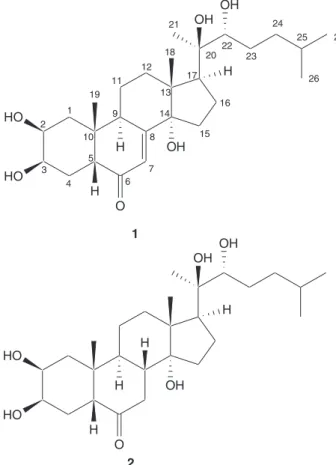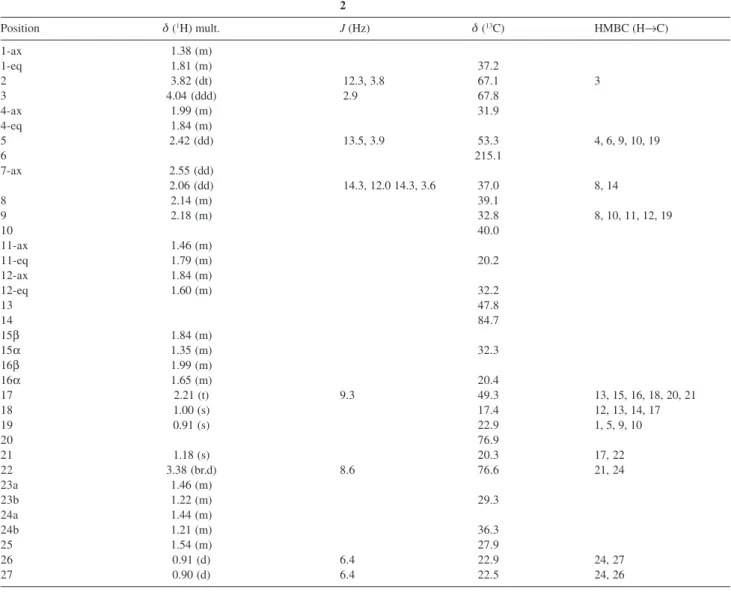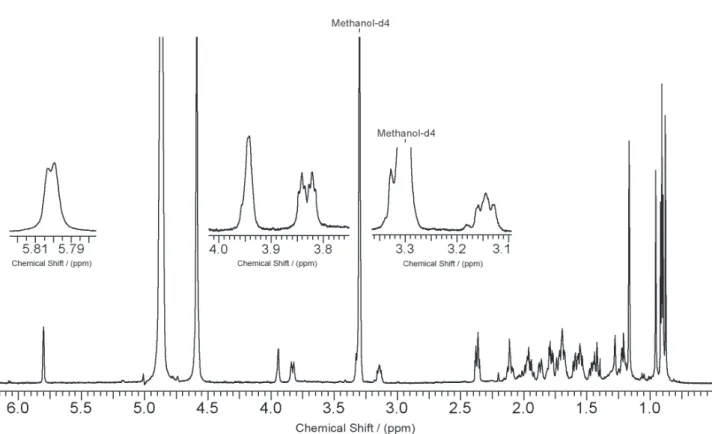Printed in Brazil - ©2007 Sociedade Brasileira de Química 0103 - 5053 $6.00+0.00
Short Report
*e-mail: shiqingwen@hebmu.edu.cn; kiyota@biochem.tohoku.ac.jp
7,8
β
β
β
β
β
-Dihydroponasterone A, a New Phytoecdysteroid from the Needles of the
Japanese Yew,
Taxus cuspidata
Qing-Wen Shi,*,a Mei Dong,a Chang-Hong Huo,a Xiao-Hui Su,a Xing Li,a Teiko Yamadab and Hiromasa Kiyota*,b
a
Department of Natural Product Chemistry, School of Pharmaceutical Sciences, Hebei Medical University, 361 Zhongshan East Road, 050017, Shijiazhuang, Hebei Province, P. R. China
b
Laboratory of Applied Bioorganic Chemistry, Division of Biocience & Biotechnology for Future Bioindustry, Graduate School of Agricultural Sciences, Tohoku University, 1-1 Tsutsumidori-Amamiya, Aoba-ku, Sendai 981-8555, Japan
O novo ecdisteróide 7,8β-di-hidroponasterona A e a ponasterona A, foram isolados a partir do extrato metanólico das agulhas do teixo japonês Taxus cuspidata. As estruturas foram elucidadas por meios espectroscópicos, nomeadamente, RMN 13C e 1H, COSY 1H-1H, NOESY,
HMQC e HMBC, e confirmadas por HR-FABMS.
A new plant ecdysteroid 7,8β-dihydroponasterone A, together with ponasterone A, were isolated from the methanol extract of the needles of the Japanese yew, Taxus cuspidata. Their structures were elucidated on the basis of spectroscopic analysis including 1H NMR, 13C NMR, 1H-1H COSY, NOESY, HMQC and HMBC and confirmed by high-resolution FABMS data.
Keywords:Taxus cuspidata, yew, phytoecdysteroid, ponasterone A, 7,8β-dihydroponasterone A
Introduction
Phytoecdysteroids are steroidal molecules firstly recognized as hormones controlling mounting and metamorphosis in insects. Today it is realized that these steroids are present at all stages of insect development, regulating many biochemical and physiological processes.1 Ecdysteroids and their analogs are also of
great interest for medicinal application.2 To date, more
than 200 phytoecdysteroids were identified,3,4 however,
only four of them were isolated from the genus Taxus (yew trees).5 The Japanese yew, Taxus cuspidata
(Taxaceae), is a low trailing bush or tree very popular in Hokkaido and Tohoku regions, widely used as ornamental plant in Japan. Previous phytochemical studies on this species let to the isolation of taxanes with various skeleton, and other classes of compounds.5,6 Here
we report on the isolation and identification of a new phytoecdysteroids, 7,8β-dihydroponasterone A (2), as well as the known ponasterone A (1) from the needles of T. cuspidata.
Results and Discussion
A methanolic extract of the needles of Taxus cuspidata was processed as described in the experimental section to afford compounds 1 and 2 (Figure 1). Combined analysis of NMR7 and FAB-MS data of compound 1, obtained as a
white amorphous solid, established its structure as ponasterone A, which has been previously isolated from the bark of T. brevifolia,8T. cuspidata,9and T. yunnanensis.10
Compound 2 was obtained as a white amorphous solid with a molecular formula C27H46O6 calculated from the peaks at m/z 489.3193 (M+Na)+ and 505.2921 (M+K)+ in
the HR-FABMS. The spectroscopic data of 2 (Table 1) closely resembles those of 1, with the exceptions that in compound 2 the olefinic carbons and the olefinic proton were absent, the ketone resonance was shifted from δC 206.4
to 215.1 ppm, and its UV spectrum lacked the characteristic absorption for the α,β-unsaturated ketone at 242 nm.11,12
Based on these features it was concluded that the structure of 2 corresponded to the 7,8-dihydro derivative of 1.
The relative stereochemistry of 2 was deduced from NOESY data and 1H-1H coupling constants of vicinal
1082 7,8β-Dihydroponasterone A, a New Phytoecdysteroid J. Braz. Chem. Soc.
AB rings was elucidated from the coupling constants (J1ax,2 12.3 Hz, and J3,2 = J3,4ax = J3,4eq = 2.9 Hz), and the NOESY correlations of H-2 to H-4ax, H-2 to H-9, H-5 to H-19, and H-4ax to H-7ax. The hydroxy groups at C-2 and C-3 were to be β-oriented, judging from the small coupling constant between H-2 and H-3. The NOE correlations between H-7ax to H-9, H-8 to H3-18, H-8 to H3-19, and H-9 to H-12ax demonstrated the BC ring was trans-fused. trans-Fusion of the CD-rings was
deduced from the similarity of the 1H NMR chemical
shifts and coupling constant values to 1 and the NOESY correlation of H-15β to H3-18. The β-orientation of the side chain C-20-C-27 was deduced from the NOE between H-12ax to H-17. C-20-OH and C-22-OH were assigned to be β- and α-oriented, respectively, by comparing with the analogous compound.13
Conse-quently, the compound 2 was determined to be 7,8β -dihydroponasterone. The corresponding 8α-diastereomer of 2 was previously synthesized by stereoselective catalytic hydrogenation of 1.14
Compound 2 was formerly reported as a hypothetical CoMFA model compound to investigate QSAR of ecdysteroids.15 Phytoecdysteroids appeared to have
ago-nistic activity at the insectsteroid receptor complex,15,16
and participate in the defense of plant against non-adapted phytophagous invertebrates.1,17 The fact that yew
trees exhibited a very strong resistance to insect pests was considered to be caused by taxanes such as 10-deacetylbaccatin III and 10-10-deacetylbaccatin V.18 The
presence of 1 and 2 in the needles of the Japanese yew would also be responsible for insecticidal activity.19
Experimental
General experimental procedure
Optical rotations: a JASCO DIP-370 digital polarimeter. Flash chromatography: Silica gel 60 (230-400 mesh EM Science). Thin layer chromatography: Silica Gel 60 F254 pre-coated TLC plates (0.25 mm or 0.5 mm, EM Science). Analytical HPLC: a Waters 600 FHU delivery system and a PDA 996 detector, and Whatman partisil 10 ODS-2 (4.6 ×
250 mm) column. Preparative HPLC: a Waters Delta Prep 3000 instrument and a UV 486 detector (210 nm, Waters), and Whatman partisil 10 ODS-2 Mag-9 (9.4 × 250 mm) or partisil 10 ODS-2 MAG-20 (22 × 500 mm) column, eluent: a 50 min linear gradient of acetonitrile (25 to 100%) in water (18 mL min-1). NMR: a Bruker Avance-500 spectrometer
(500 MHz for 1H and 125 MHz for 13C). The solvent was
used as an internal reference. FAB-MS: a Vacuum Generators ZAB-HS double-focusing instrument.
Plant material
The needles of Taxus cuspidata were collected in the autumn of 2000 at Tsutsuzigaoka park, Sendai city in the north-east of Japan. The botanical identification was made by Professor T. Oritani of Toyama Prefectural University, Toyama, Japan. Several voucher specimens have been deposited in the Laboratory of Applied Bioorganic Figure 1. Ponasterone (1) and 7,8β-dihydroponasterone (2) isolated from
Taxus cuspidata.
O OH H HO H 1 2 3 4 5 6 7 8 9 10 11 12 13 14 15 16 17 18 19 20 21 22 23 25 24 26 27 O OH H HO H 1 2 H OH OH H OH OH H HO HO
Figure 2. Relative stereochemistry of 7,8β-dihydroponasterone A (2). The arrows denote selected NOESY correlations.
H12a Me19 H5 HO HO H9 H8 O H3 H4e H4a H2 H7a H1a H1e Me18 OH H17 H16β
H15β H12e
H16α
Chemistry, Graduate School of Agricultural Sciences, Tohoku University, Japan.
Extraction and isolation
Air-dried needles of Taxus cuspidata were ground (3.0 kg) and extracted with 8 L of methanol for one week at room temperature. The plant material was filtered, and extracted again with fresh solvent for another two times (each time with 4 L solvent, total 16 L) in seven days. The combined organic extracts were evaporated under reduced pressure. Water (2 L) was added, and lipids were removed by stirring the mixture with hexane (3 × 2 L). The aqueous phase was then salted (NaCl, 150 g) and extracted with CH2Cl2 (4 × 1 L). The combined CH2Cl2 extracts were dried with anhydrous sodium sulfate, filtered and evaporated yielding a dark green extract (45 g). A
portion of the methylene chloride extract (38 g) was absorbed onto silica gel (45 g) and packed on a wet column chromatography (silica gel, 820 g). Successive elution with CH2Cl2-MeOH gradient with increasing amounts of methanol from 5% to 45% (total 10 L) yielded 32 fractions (FrD-1 to FrD-32). FrD-27 to FrD-30 were combined (14 g) and chromatographed over silica gel (470 g), being eluted with a stepwise hexane-acetone gradient (1:1, 3:4, 2:3) to yield 28 fractions (FrD-27-1 to FrD-27-28). The fractions FrD-27-16,FrD-27-17 and FrD-27-18 (640 mg) were pooled and re-chromatographed over silica gel (50 g) eluting with hexane-EtOAc (1:2) to yield 17 fractions (FrD-27-16-1 to FrD-27-16-17). The fractions FrD-27-16-14 (18 mg) and FrD-27-16-15 (21 mg) were combined and applied to preparative HPLC to yield 1 (7 mg, tR = 22.32 min). FrD-27-19 to FrD-27-28 (1.59 g) were absorbed onto 3.0 g silica gel and re-chromatographed over silica gel, being eluted using stepwise gradients of CH3CN in Table 1.1H and 13C NMR data of 2 in CDCl
3 (500 MHz for
1H, 125 MHz for 13C)
2
Position δ (1H) mult. J (Hz) δ (13C) HMBC (H→C)
1-ax 1.38 (m)
1-eq 1.81 (m) 37.2
2 3.82 (dt) 12.3, 3.8 67.1 3
3 4.04 (ddd) 2.9 67.8
4-ax 1.99 (m) 31.9
4-eq 1.84 (m)
5 2.42 (dd) 13.5, 3.9 53.3 4, 6, 9, 10, 19
6 215.1
7-ax 2.55 (dd)
2.06 (dd) 14.3, 12.0 14.3, 3.6 37.0 8, 14
8 2.14 (m) 39.1
9 2.18 (m) 32.8 8, 10, 11, 12, 19
10 40.0
11-ax 1.46 (m)
11-eq 1.79 (m) 20.2
12-ax 1.84 (m)
12-eq 1.60 (m) 32.2
13 47.8
14 84.7
15β 1.84 (m)
15α 1.35 (m) 32.3
16β 1.99 (m)
16α 1.65 (m) 20.4
17 2.21 (t) 9.3 49.3 13, 15, 16, 18, 20, 21
18 1.00 (s) 17.4 12, 13, 14, 17
19 0.91 (s) 22.9 1, 5, 9, 10
20 76.9
21 1.18 (s) 20.3 17, 22
22 3.38 (br.d) 8.6 76.6 21, 24
23a 1.46 (m)
23b 1.22 (m) 29.3
24a 1.44 (m)
24b 1.21 (m) 36.3
25 1.54 (m) 27.9
26 0.91 (d) 6.4 22.9 24, 27
1084 7,8β-Dihydroponasterone A, a New Phytoecdysteroid J. Braz. Chem. Soc.
CH2Cl2 to give 25 fractions (FrD-27-19-1 to FrD-27-19-25). FrD-27-19-24 (170 mg) was subjected to preparative HPLC. The material eluted at tR = 20.18 min was collected and concentrated (25 mg), and further purified by preparative TLC with EtOAc-EtOH (100:6) elution, to yield 2 (3.5 mg, Rf = 0.40).
Ponasterone A (1)
Amorphous solid; [α]D22 +68° (c 0.20, MeOH).
7,8β-Dihydroponasterone A (2)
Amorphous solid; [α]D22 +76° (c 0.20, MeOH); 1H and 13C NMR spectral data, see Table 1. HRFABMS: m/z
489.3193 [M+Na]+ (Calc. for C
27H46O6Na, 489.3192),
505.2921 [M+K]+ (Calc. for C
27H46O6K, 505.2931).
Acknowledgments
We thank Scientific Research Foundation for the Returned Overseas Chinese Scholars, State Education Ministry of China and the Foundation for Researching New Drugs of China for the financial support in part. No: 2003AA2Z3527.
Supplementary Information
Supplementary data of compound 1 are available free of charge at http://jbcs.sbq.org.br, as PDF file.
References
1. Dinan, L.; Phytochemistry2001, 57, 324.
2. Akhren, A. A.; Kovganko, N.V.; Ekdisteroidy: Khimia I Biologicheskaya Aktivnost (Ecdysteroids: Chemistry and
Biological Activity), Nauka I Tekhnika: Minsk, 1989.
3. Nakanishi, K.; Koreeda, M.; Sasaki, L.; Chang, M. L.; Hsu, H.
Y.; J. Chem. Soc., Chem. Commun.1966, 915.
4. Lafont, R.; Wilson, I. D.; The Ecdysone Handbook, 2nd ed., The Chromatographic Society: Nottingham, UK, 1996; http:// ecdybase.org/, accessed in February 2006.
5. Parmar, V. S.; Jha, A.; Bish, K. S.; Taneja, P.; Sight, S. K.; Kumar, A.; Poonam, J. R; Olsen, C. E.; Phytochemistry1999, 50, 1267. 6. Baloglu, E.; Kingston, D. G. I.; J. Nat. Prod.1999, 62, 1448; Kobayashi, J.; Shigemori, H.; Med. Res. Rev.2002, 22, 305 and references cited therein; Shi, Q. W.; Kiyota, H.; Chem.
Biodivers.2005, 2, 1597;Shi, Q. W.; Oritani, T.; Horiguchi,
T.; Sugiyama, T.; Murakami, R.; Yamada, T.; Biosci.,
Biotechnol., Biochem.1999, 63, 924; Shi, Q. W.; Oritani, T.;
Sugiyama, T.; Horikuchi, T.; Murakami, R.; Zhao, D.; Oritani,
T.; Tetrahedron1999, 55, 8365.
7. Vokác, K.; Budesinsky, M.; Harmatha, J.; Kohoutová, J.;
Phytochemistry1998, 49, 2109.
8. Rao, K. V.; Bhakuni, R. S.; Hanuman, J. B.; Davies, R.; Johnson,
J.; Phytochemistry1996, 41, 863.
9. Imai, S.; Nakanishi, K.; Koreeda, M; Kurokawa, T.; Steroids
1967, 10, 557; Ripa, P. V.; Martin, E. A.; Cocciolone, S. M.; Adler, J. H.; Phytochemistry 1990, 29, 425; Takemoto, T.; Hikino, Y.; Jin, H., Hikino, H.; Yakugaku Zasshi 1968, 88, 359. 10. Li, S. H.; Zhang, H. J.; Yao, P.; Niu, X. M.; Xiang, W.; Sun, H.
D.; J. Asian Nat. Prod. Res.2002, 4, 147.
11. The UV absorption was checked by the UV detecter for HPLC. 12. Costantino, V.; Carmela D.; Fattorusso, E.; Mangoni, A.;
Steroids2000, 65, 138.
13. Ruan, B.; Wilson, W. K.; Schroepfer Jr., G. J.; Steroids 1999,
64, 385.
14. Suksamrarn, A.; Tanachatchairatana, T., Sirigarn, C.;
Tetrahedron2002, 58, 6033.
15. Dinan, L.; Hornann, R. E.; Fujimoto, T.; J. Comput. Aid. Mol.
Des. 1999, 13, 185.
16. Dinan, L.; Savchenko, T.; Whiting, P.; Sarker, S.D.; Pestic. Sci.
1999, 55, 331.
17. Slama, K.; Lafont, R.; Eur. J. Entomol.1995, 92, 355. 18. Daniewski, W. M.; Gumulka, M.; Anczewski, W.; Masnyk, M.;
Bloszyk, E.; Gupta, K. K.; Phytochemistry1998, 49, 1279. 19. Horn, D. H. S. In Naturally Occurring Insecticides; Jacobson,
M.; Crosby, D. G., eds.; Marcel Dekker: New York, 1971, p. 333.
Printed in Brazil - ©2007 Sociedade Brasileira de Química 0103 - 5053 $6.00+0.00
Supplementary Information
*e-mail: shiqingwen@hebmu.edu.cn; kiyota@biochem.tohoku.ac.jp
7,8β
β
β
β-Dihydroponasterone A, a New Phytoecdysteroid from the Needles of the
β
Japanese Yew,
Taxus cuspidata
Qing-Wen Shi,*,a Mei Dong,a Chang-Hong Huo,a Xiao-Hui Su,a Xing Li,a Teiko Yamadab and Hiromasa Kiyota*,b
a
Department of Natural Product Chemistry, School of Pharmaceutical Sciences, Hebei Medical University, 361 Zhongshan East Road, 050017, Shijiazhuang, Hebei Province, P. R. China
b
Laboratory of Applied Bioorganic Chemistry, Division of Biocience & Biotechnology for Future Bioindustry, Graduate School of Agricultural Sciences, Tohoku University, 1-1 Tsutsumidori-Amamiya, Aoba-ku, Sendai 981-8555, Japan
Figure S1. 1H NMR data of compound 1 in CDCl
S2 7,8β-Dihydroponasterone A, a New Phytoecdysteroid J. Braz. Chem. Soc.
Figure S2. 1H NMR data of compound 1 in CDCl



